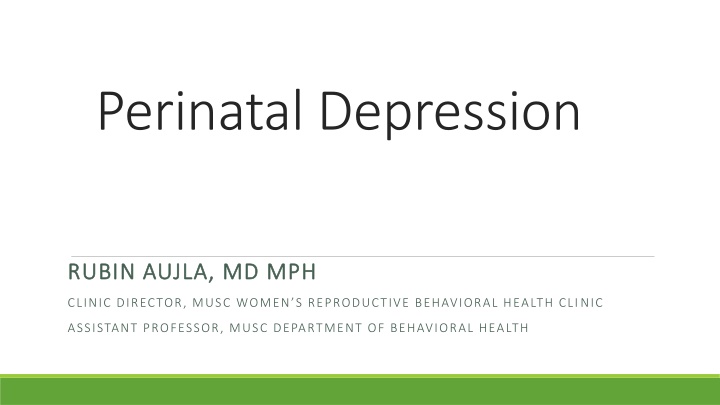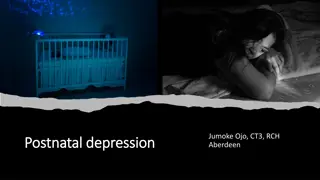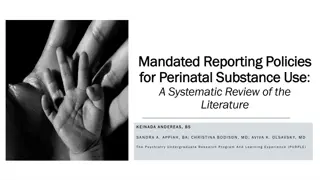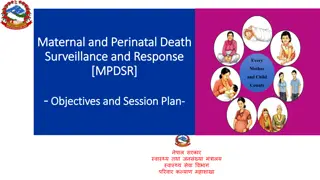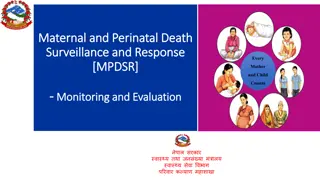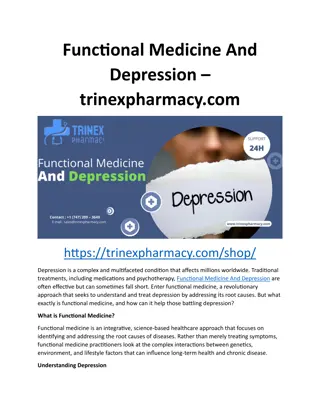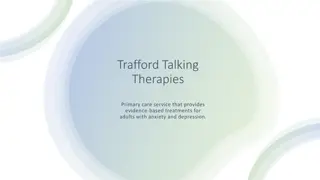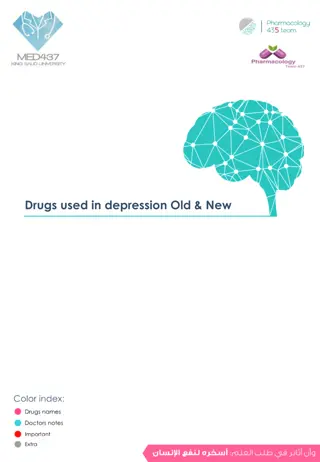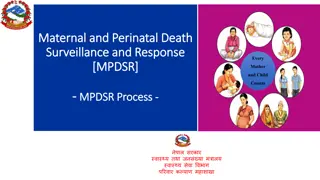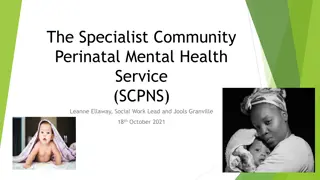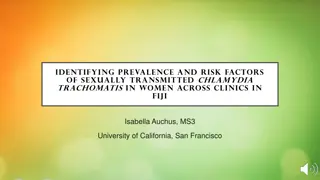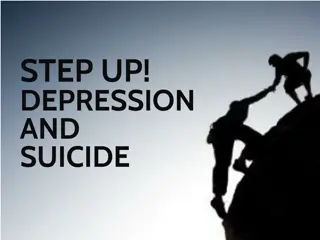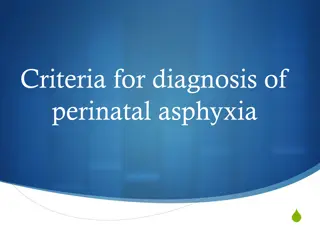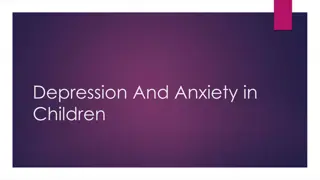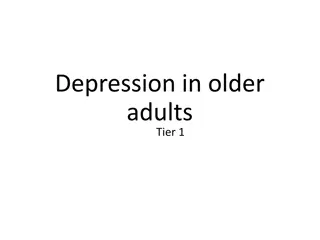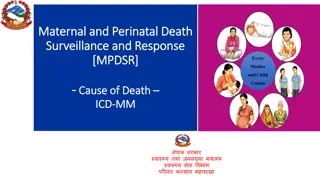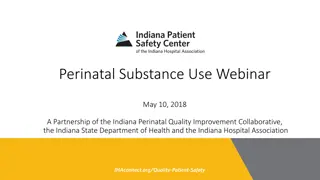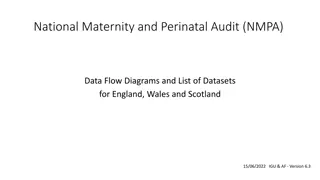Perinatal Depression: Diagnosis, Prevalence, Risk Factors
Perinatal depression, a common complication of childbirth, includes postpartum depression and perinatal mood disorders. Symptoms can vary during pregnancy and postpartum period. Risk factors encompass history of mental health issues, stressful events, and lack of support. Screening tools such as EPDS and PHQ-9 aid in early detection, leading to effective treatment and referral to specialized clinics like WRBH. Understanding the differences between postpartum depression and perinatal mood disorders is crucial for maternal and child well-being.
Download Presentation

Please find below an Image/Link to download the presentation.
The content on the website is provided AS IS for your information and personal use only. It may not be sold, licensed, or shared on other websites without obtaining consent from the author.If you encounter any issues during the download, it is possible that the publisher has removed the file from their server.
You are allowed to download the files provided on this website for personal or commercial use, subject to the condition that they are used lawfully. All files are the property of their respective owners.
The content on the website is provided AS IS for your information and personal use only. It may not be sold, licensed, or shared on other websites without obtaining consent from the author.
E N D
Presentation Transcript
Perinatal Depression RUBIN AUJLA, MD MPH RUBIN AUJLA, MD MPH CLINIC DIRECTOR, MUSC WOMEN S REPRODUCTIVE BEHAVIORAL HEALTH CLINIC ASSISTANT PROFESSOR, MUSC DEPARTMENT OF BEHAVIORAL HEALTH
Objectives Objectives Diagnosis Prevalence Risk factors Maternal, fetal, newborn and child impact Treatment Referral to WRBH Clinic
PPD vs PMAD PPD vs PMAD PPD: Postpartum Depression PMAD: Perinatal Mood and Anxiety Disorders Depression, Anxiety, OCD, PTSD/trauma, Bipolar, Psychosis, Eating disorders, ADHD Substance Use disorders Perinatal loss, infertility
Perinatal Depression Perinatal Depression Episode of Major Depressive Disorder (MDD) Same Specifiers with anxious distress Additional Specifier: in perinatal/postpartum setting Pregnancy Postpartum 4 wks vs 1 yr after delivery
Peripartum Depression Onset Varies Across Guidelines
Perinatal Depression is the most common complication of childbirth Rates (%) of common childbirth complications3-10 PPD Preterm delivery Gestational diabetes Hypertension Pre-eclampsia Postpartum hemorrhage 0 2 4 6 8 10 12 14 16
Screening in Pregnancy and Postpartum EDPS: review item 10; Score 10/13 + PHQ-9: review item 9; Score 10 +
Risk Factors for Perinatal Depression Risk Factors for Perinatal Depression History of Depression, Anxiety Prior to or during pregnancy Stressful Life Event/Neonatal Diagnosis Traumatic Birth NICU Admission Poor Marital/Partner Relationship Poor Social Support Low Socioeconomic Status History of Traumatic Experience(s) Domestic Violence, Childhood Sexual Abuse
Potential Impact of Untreated Depression Potential Impact of Untreated Depression Patient Obstetric/Fetal Child Development
Suicide Suicide (especially in combination with drug OD) is the leading cause of perinatal mortality Is strongly associated with depressive symptoms, however, can be associated with other mood/anxiety disorders, substance use, etc 3.3% of women hospitalized with a postpartum psychiatric illness complete suicide
Passive vs Active Suicidal Ideation (SI): Passive SI Are you having thoughts about just wanting to go to sleep and not waking up? Active SI with a plan Have you thought of ways that you would end your life? If so, how? Have you started preparing to do that? Do you have the means to do that? (e.g., access to gun, pills etc.)
Impact on Intimate Partner Relationship PPD increases the risk for Problems in relationships PPD precedes problems/conflict in relationship Paternal depression 25-50% of men whose partners have PPD 2.5 times more likely in individual whose partners have PPD
Obstetric/Fetal Impact Poor Self-care, Nutrition & Prenatal Care Alcohol, Drugs and Nicotine Use Nausea, Vomiting, Hyper-emesis Spontaneous miscarriage Pre-eclampsia Unplanned C-section Preterm Birth (higher risk with depression severity) Low Birth Weight (higher risk with depression severity) Lower APGAR scores
In comparison to children of parents without PPD, children of parents with PPD are significantly more likely to: 3 Infant behaviors (difficulty sleeping, demanding, difficult to comfort) Weeks 4 Unintentional injury Months 6 Impaired mother-infant bonding Months 12 Worse communication skills Months 18 Decrease in cognitive and fine motor development Month Emotional, conduct, and behavioral difficulties 4 Years Attenuated growth 6 Years Psychological difficulties 10 Years Adolescent depression 18 years
Risks of Untreated Perinatal Depression: Patient Patient Poor health habits Poor health habits Relationships Relationships Severity of illness/Suicide Severity of illness/Suicide Obstetric/Fetal Obstetric/Fetal C C- -section section LBW (OR 1.96) LBW (OR 1.96) PTB (OR 1.56) PTB (OR 1.56) Child Development Child Development Less likely to breastfeed Less likely to breastfeed Child Development: Child Development: Sleep, mother Sleep, mother- -infant bonding, communication, cognition, fine motor, behavioral, academics, psychiatric infant bonding, communication, cognition, fine motor, behavioral, academics, psychiatric
Treatment: Cognitive Behavioral Therapy, Interpersonal Psychotherapy Medications (Antidepressants) Brain Stimulation: rTMS Zulresso IV infusion Bright Light Therapy, Yoga, Exercise, Mindfulness, Acupuncture, Omega 3 Fatty Acids, Group Therapy
Antidepressants Antidepressants Risks in pregnancy Risks in pregnancy PTB 3 day shorter gestational age LBW 75 grams (2.6 ounces) lower birth weight NAS PPHN
Neonatal Adaptation Syndrome (NAS) ~ 30% of newborns exposed to SSRIs Onset after delivery, peak 2-3 days Symptoms short-term, full recovery by 2 weeks postpartum Symptoms: Irritability, tremors, jitteriness, muscle tone Trouble feeding, agitation, respiratory distress and poor sleep Less common: abnormal posturing and shivering Rare: seizure
Persistent Persistent Pulmonary HTN Pulmonary HTN of the Newborn of the Newborn (PPHN) (PPHN) Persistence of Fetal Circulation Population rate: 1-2/1000 Risk with SSRI s: 3/1000 Mortality Rate: 6-12%
SSRI & Malformation Risk Once controlling for confounders, no clinically increased significant risk for malformation No consistent malformation that stands out Exception: Paxil: Black Box warning for risk for cardiac malformation
Additional potential SSRI Risks: Apgar Score? <1/2 point Autism spectrum? Non-significant risk once controlling for confounders including maternal mental illness Child Development: Slightly lower psychomotor scores on Bayley Scales of Infant Development, however resolved with age
In comparison to children with in-utero exposure to SSRIs, children exposed to SSRIs are NOT more likely to demonstrate differences in 15 cognitive, language, behavioral development Months 18 externalizing, internalizing behaviors Months 24 speech or motor development ? Months 36 externalizing, internalizing behaviors Months 48 neuropsych testing Months 71 cognitive, language, behavioral development Months 72 neuropsych testing Months
Risk vs Risk Summary Risks of Perinatal Depression: Risks of Perinatal SSRI Use: Women Women Poor health habits Relationships Severity of illness/Suicide Obstetric/Fetal LBW/SGA Cardiac Malformations/Paxil PTB (OR 1.24-1.53) PPHN (3/1,000) NAS (30%) Obstetric/Fetal C-section LBW (OR 1.96) PTB (OR 1.56) Child Development Less likely to breastfeed Child Development: Sleep, mother-infant bonding, communication, behavior, academics, cognition, fine motor, psychiatric Child Development Delayed motor and control development, but resolved with age
Zulresso (Brexanolone / Allopregnanolone): FDA approved for postpartum depression MDD, severe, in postpartum setting (up to 1 year postpartum) Positive allosteric modulator of GABA s action at GABA A Exclusion Criteria includes but not limited to bipolar d/o, psychosis and certain medical conditions NOT a treatment for acute SI
Zulresso (Brexanolone / Allopregnanolone): Process starts with a WRBH clinic intake If meets criteria and patient interested, scheduled for more in-depth screening Insurance Inpatient admission at MUSC Continuous 3 day IV infusion with monitoring Patient can be on antidepressants, can be breastfeeding
Antidepressants and Breastfeeding Overall, antidepressants are considered compatible with breastfeeding - L level: level of human research - Relative Infant Dose (RID): ideally <10% - Greater exposure in utero than via breastmilk - Resource: Hales Medications & Mother s Milk (book, website)
How to Refer to WRBH Clinic if you are not an MUSC Provider: To refer a patient: WRBH Clinic Phone Number: (843) 792-9419 For a provider-to-provider phone consult: (843) 792-6667 (792-MOMS)
How to Refer to WRBH Clinic from with MUSC: Amb Referral to Behavioral Health Walk-In Cannon
How to Refer Pregnant Patients with Opioid Use Disorder: Patient or Provider can text/call the MOMs Phone: (843) 614-9510
Thank you Questions? aujlar@musc.edu
